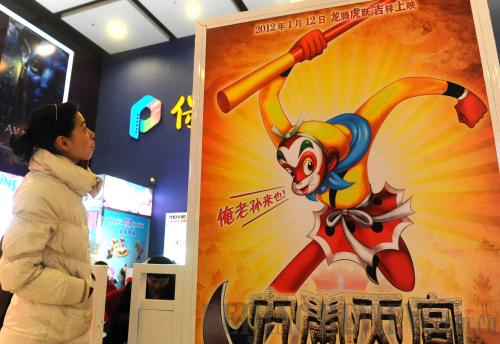|
 |
|
CLASSICS REBORN: The animated feature The Monkey King: Uproar in Heaven 3D is on show at cinemas in Beijing in January, 2012. It has done well in box office due largely to its status as a classic of Chinese animation (CFP) |
A Chinese animated feature The Monkey King: Uproar in Heaven 3D, which combines classic Chinese animation and 3D technology, premiered at the New York International Children's Film Festival 2012 which opened on March 2.
The original Monkey King: Uproar in Heaven is perhaps the best-known animated film in China. Premiering in 1965, the film was created by hand from over 130,000 ink drawings, and represented the height of China's achievement in animation during the 1960s. The story is based on the first seven chapters of the Chinese classic Journey to the West as the Monkey King rebels against the Jade Emperor of Heaven.
To create the 3D version, the owner of the right to the original version, Shanghai Animation Film Studio (SAFS), worked with Technicolor, a U.S. studio specialized in animation technology, which helped with the film's restoration, and conversion from 2D. Both the U.S. and Chinese teams worked on the project for over one year.
At the press conference launching the renovated movie on December 8 last year, Qian Jianping, the film producer, said, "In cooperation with Technicolor, we have polished the colors, applied 3D technologies and created more sound effects."
Their newly founded joint venture, Technicolor-SFG Technology Co. Ltd., will work to bring advanced animation technologies to Chinese studios.
Technicolor isn't the only Western animation company making forays into the Chinese market. The Walt Disney Co., the world's largest animation entertainment group, also regards the Chinese mainland as an increasingly significant emerging market. In early 2005, Disney moved its Asia-Pacific headquarters from Hong Kong to Shanghai. Today Disney has built an integrated sales network across China. Many Chinese animation companies have also chosen to cooperate with Disney to develop and market their products.
CPE signed a three-year broadcasting license contract with Disney in 2010, through which the Pleasant Goat and Big Big Wolf series would be broadcast in 52 countries and territories in the Asia-Pacific region in more than 10 languages. It was the first time for a Chinese animated TV series to be distributed so extensively at home and abroad.
"Only by competing in overseas markets can Chinese animation brands achieve big success," said Su Yongle, President of CPE.
On February 17, 2012, DreamWorks announced that it entered into agreement with three Chinese companies to form Oriental DreamWorks, which will engage in the development and production of high-quality original Chinese animated and live action content for distribution both within China and around the globe.
Although many people worry about the impact of international animation giants entering the Chinese market, others believe Chinese animation will benefit from international investment through cooperation and competition.
Despite the industry's rapid growth and the fact that China is now the largest producer of animated cartoons in terms of quantity, the industry still struggles to generate sufficient revenue.
Sun Lijun, Dean of the School of Animation of Beijing Film Academy, said the output value of the U.S. animation industry exceeds $200 billion each year, but that of China was a meager $1.58 billion in 2011. Currently, Japan's animation products take up 65 percent of the total market share in the world.
Qian pointed out several challenges that hinder the development of Chinese animation industry. One is the lack of good ideas and stories, and another is the relatively backward technology.
"Advanced technology enables Hollywood studios to fully realize the producers' ideas. So we need to master new technologies through cooperation," he said.
"Crucially, the animation industry must establish its own distinct identity rather than copying American or Japanese styles. We need to establish our own features and brands," Qian added.
Furthermore, the animation industry needs to resolve the investment problem. Due to the slender income from box office sales and copyright licenses, many animation studios don't receive the investment they need to produce better works.
Despite all these challenges, the Chinese animation industry is embarking on a period of rapid growth and now policy incentives are being introduced to accelerate the industry's development. In the eyes of animators, the animation industry is on the cusp of a new golden age and it's only a matter of time before the industry tackles the above-mentioned challenges and emerges as a truly global force.
Email us at: baishi@bjreview.com | 